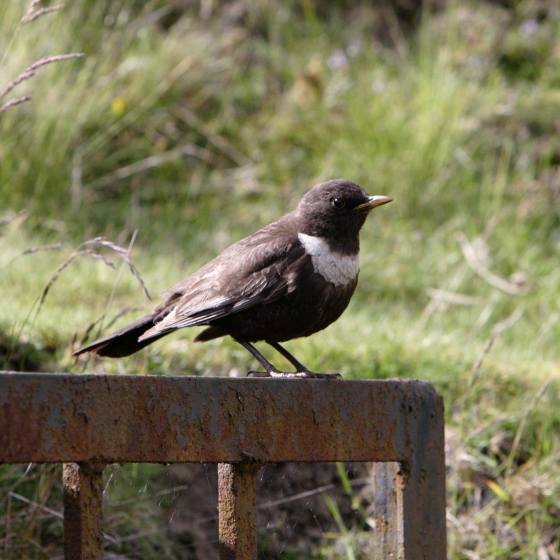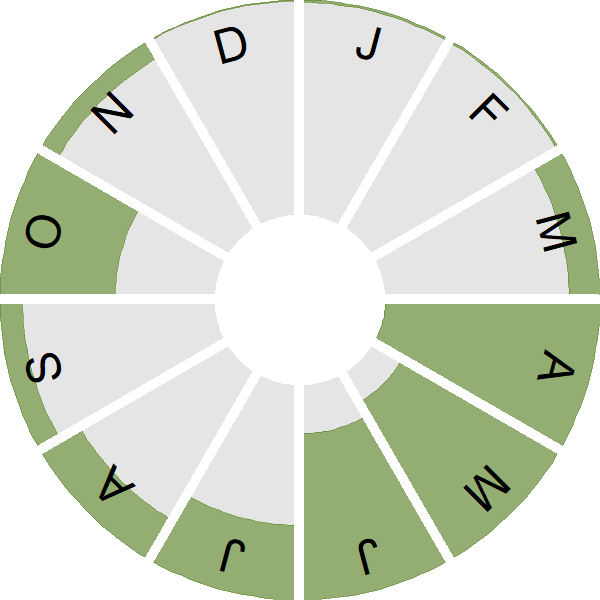Ring Ouzel

Introduction
This striking Thrush, a little larger than a Blackbird, is a bird of our uplands, breeding from Dartmoor to the Scottish mountains.
The white bib of the male and creamy bib of the female combined with a silvery wing panel set this thrush apart from all others. It is also the only thrush that visits Britain & Ireland just for the summer months, arriving in mid-March and departing during September and October, spending the winter as far south as North Africa. In recent years a handful of birds have been found in the UK during the winter, mostly in gardens.
Ring Ouzel has been on the UK Red List since 2002 due to long-term declines in breeding population and range.
- Our Trends Explorer gives you the latest insight into how this species' population is changing.

Key Stats
Identification
ID Videos
This section features BTO training videos headlining this species, or featuring it as a potential confusion species.
Ring Ouzel and Blackbird
Songs and Calls
Song:
Alarm call:
Flight call:
Status and Trends
Conservation Status
Population Change
This species has been monitored by single species surveys: a 58% population decline was estimated for the period between 1988-91 and 1999, warranting red listing (Gregory et al. 2002). Further fieldwork in 2012 found 5,332 territories (4,096-6,875), using the same methods as in 1999; This equated to a (non-significant) decline of 29% since 1999 (Wotton et al. 2016). The 2012 study also used playback to measure the efficiency of the national survey methods and estimated that 84% of territories were located in 2012, giving a revised population estimate of 6,348 territories (4,825-8,198). Along with the population decline, the range of Ring Ouzel has also contracted: By 2008-11, the number of occupied 10-km squares had fallen by 43% since 1968-72 (Balmer et al. 2013).
Numbers across Europe have been broadly stable since 1998 (PECBMS: PECBMS 2020a>).
Distribution
As a breeding species the Ring Ouzel is a bird of the uplands, having a mostly northern and western distribution. It is a very localised breeder in Ireland.
Occupied 10-km squares in UK
2007/08–10/11
or view it on Bird Atlas Mapstore.
2008–11
or view it on Bird Atlas Mapstore.
European Distribution Map
Distribution Change
The Ring Ouzel breeding range has contracted by 43% in Britain and by 57% in Ireland since the 1968–72 Breeding Atlas. Recent losses mean Ring Ouzels no longer breed in Exmoor and they are now largely absent from most of central Wales, the western half of the Scottish Southern Uplands and Co. Wicklow. In Scotland north of the Central Belt, Ring Ouzels have contracted from the range margins, particularly in the southwest and far north. Intensive studies confirm many breeding populations throughout Britain are in decline.
Change in occupied 10-km squares in the UK
from 1981–84 to 2007–11
or view it on Bird Atlas Mapstore.
from 1968–72 to 2008–11
or view it on Bird Atlas Mapstore.
Seasonality
Ring Ouzel is a summer visitor and passage migrant, arriving from mid March onwards; there is a pronounced passage of continental birds in October.
Weekly pattern of occurrence
The graph shows when the species is present in the UK, with taller bars indicating a higher likelihood of encountering the species in appropriate regions and habitats.

Movement
Britain & Ireland movement
Foreign locations of birds ringed or recovered in Britain & Ireland
Dots show the foreign destinations of birds ringed in Britain & Ireland, and the origins of birds ringed overseas that were subsequently recaptured, resighted or found dead in Britain & Ireland. Dot colours indicate the time of year that the species was present at the location.
- Winter (Nov-Feb)
- Spring (Mar-Apr)
- Summer (May-Jul)
- Autumn (Aug-Oct)

European movements
EuroBirdPortal uses birdwatcher's records, such as those logged in BirdTrack to map the flows of birds as they arrive and depart Europe. See maps for this species here.
The Eurasian-African Migration Atlas shows movements of individual birds ringed or recovered in Europe. See maps for this species here.
Biology
Productivity and Nesting
Nesting timing
Egg measurements
Clutch Size
Incubation
Fledging
Survival and Longevity
Survival is shown as the proportion of birds surviving from one year to the next and is derived from bird ringing data. It can also be used to estimate how long birds typically live.
View number ringed each year in the Online Ringing Report.
Lifespan
Survival of adults
Survival of juveniles
Biometrics
Wing length and body weights are from live birds (source).
Wing length
Body weight
Ring Size
Classification, names and codes
Classification and Codes
- Order: Passeriformes
- Family: Turdidae
- Scientific name: Turdus torquatus
- Authority: Linnaeus, 1758
- BTO 2-letter code: RZ
- BTO 5-letter code: RINOU
- Euring code number: 11860
Alternate species names
- Catalan: merla de pit blanc
- Czech: kos horský
- Danish: Ringdrossel
- Dutch: Beflijster
- Estonian: kaelusrästas
- Finnish: sepelrastas
- French: Merle à plastron
- Gaelic: Lòn-monaidh
- German: Ringdrossel
- Hungarian: örvös rigó
- Icelandic: Mánaþröstur
- Irish: Lon Creige
- Italian: Merlo dal collare
- Latvian: apkakles strazds
- Lithuanian: baltagurklis strazdas
- Norwegian: Ringtrost
- Polish: drozd obrozny
- Portuguese: melro-de-colar
- Slovak: drozd kolohrivec
- Slovenian: komatar
- Spanish: Mirlo capiblanco
- Swedish: ringtrast
- Welsh: Mwyalchen y Mynydd
Research
Causes of Change and Solutions
Causes of change
There is little evidence explaining either the demographic or ecological drivers of the decline in this species, although low survival between breeding seasons has been identified as a major cause of national decline.
Further information on causes of change
Long-term surveys coordinated by the Ring Ouzel Study Group confirm that declines have occurred throughout the British range (Sim et al. 2010).
British & Irish bird observatory data show a decline in spring passage Ring Ouzels at western locations during 1970-98 that matches the estimated UK breeding decline, but no decline at eastern observatories where most birds are of Fennoscandian origin (Burfield & Brooke 2005). These authors infer that, since these populations winter together, the reasons for decline among UK breeders must lie on the breeding grounds or on passage: they also point out that UK birds are more exposed to hunting pressures, particularly in southwest France.
It has proved difficult to establish any reasons for decline that are linked to the breeding grounds (Buchanan et al. 2003). In southeast Scotland, however, the breeding sites that are still occupied tend to be those at higher altitude and that have retained extensive cover of heather (Sim et al. 2007b). In the same study, it was shown that declines were greatest in years following warm summers on the breeding grounds and also greater two years after high spring rainfall in Morocco: these results suggest that the population decline could be linked to reduced food supplies, and consequently higher rates of natural mortality, in autumn and winter (Beale et al. 2006). Large areas of apparently suitable juniper scrub, with abundant berries but no wintering Ring Ouzels, exist in the Atlas Mountains, however (Green et al. 2012).
Low survival between breeding seasons is apparently a major national cause of decline (Sim et al. 2010). Within Glen Clunie, however, Sim et al. (2011) found that varying combinations of demographic factors produced each year-to-year decline, with reduced early-season productivity, rates of re-nesting and first-year survival all playing a part. A two-year experimental study found that the provision of supplementary food during the breeding season did not have an effect on reproductive success or post-fledging survival suggesting that invertebrate food availability was not a problem at this site, although the authors caution that the study area has intensive predator control so the results may only be directly relevant in similar areas (Sim et al. 2015).
Information about conservation actions
The main cause of the decline may be related to low survival between breeding seasons, and the research has not identified any clear causes of decline that are linked to the breeding grounds. Therefore, the options for taking immediate conservation action to benefit Ring Ouzels in Britain appear limited.
However, low post-fledging survival is one of the possible causes of decline which could occur on the breeding grounds. Variation in chick condition was smaller in territories with better habitat (greater grass and sedge cover and less bracken) (Davies et al. 2014); hence increased grass cover may help ensure a greater proportion of chicks are in good condition to survive immediately after fledging. Juveniles forage on invertebrates in grassland during June to mid-July, but then switch to feed mostly on berries on heather moorland until early September, so a wider variety of habitats may be needed later in the summer to support fledged young prior to migration (Sim 2012).
Publications (2)
Birds of Conservation Concern Wales 4: the population status of birds in Wales
Author: Johnstone, I.G., Hughes, J., Balmer, D.E., Brenchley, A., Facey, R.J., Lindley, P.J., Noble, D.G. & Taylor, R.C.
Published: 2022
The latest review of the conservation status of birds in Wales. The report assessed all 220 bird species which regularly occur in Wales. There are now 60 species of bird on the Red List, with 91 on ...
06.12.22
Reports Birds of Conservation Concern

Nesting dates of Moorland Birds in the English, Welsh and Scottish Uplands
Author: Wilson, M.W., Fletcher, K., Ludwig, S.C. & Leech, D.I.
Published: 2022
Rotational burning of vegetation is a common form of land management in UK upland habitats, and is restricted to the colder half of the year, with the time period during which burning may be carried ...
17.02.22
BTO Research Reports BTO Research Reports

More Evidence
More evidence from Conservation Evidence.com
Partners
Citing BirdFacts
If you wish to cite particular content in this page (e.g. a specific value) it is best to use the original sources as linked in the page. For a more general citation of the whole page please use: BTO (20XX) BirdFacts Species: profiles of birds occurring in the United Kingdom. BTO, Thetford (www.bto.org/birdfacts, accessed on xx/xx/xxxx).

